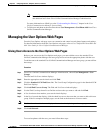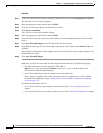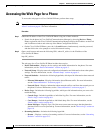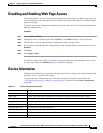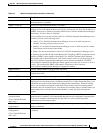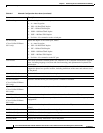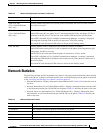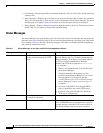
6-5
Cisco Unified IP Phone 6901 and 6911 Administration Guide for Cisco Unified Communications Manager 8.5 (SCCP and SIP)
OL-23874-01
Chapter 6 Monitoring the Cisco Unified IP Phone Remotely
Network Setup
Operational VLAN ID Auxiliary Virtual Local Area Network (VLAN) configured on a Cisco Catalyst switch in
which the phone is a member.
Admin. VLAN ID Auxiliary VLAN in which the phone is a member.
CallManager 1–5 Host names or IP addresses, in prioritized order, of the Cisco Unified Communications
Manager servers with which the phone can register. An item can also show the IP address of
an SRST router that is capable of providing limited Cisco
Unified Communications Manager
functionality, if such a router is available.
For an available server, an item will show the Cisco Unified Communications Manager server
IP address and one of the following states:
• Active—Cisco Unified Communications Manager server from which the phone is
currently receiving call-processing services.
• Standby—Cisco Unified Communications Manager server to which the phone switches
if the current server becomes unavailable.
• Blank—No current connection to this Cisco Unified Communications Manager server.
An item may also include the Survivable Remote Site Telephony (SRST) designation, which
identifies an SRST router capable of providing Cisco
Unified Communications Manager
functionality with a limited feature set. This router assumes control of call processing if all
other Cisco
Unified Communications Manager servers become unreachable. The SRST
Cisco
Unified Communications Manager always appears last in the list of servers, even if it
is active. You configure the SRST router address in the Device Pool section in
Cisco
Unified Communications Manager Configuration window.
DHCP Enabled Indicates whether DHCP is being used by the phone.
DHCP Address Released Indicates the setting of the DHCP Address Released option on the phone’s Network
Configuration menu.
Alternate TFTP Indicates whether the phone is using an alternative TFTP server.
Forwarding Delay Indicates whether the internal switch begins forwarding packets between the PC port and
switched port on your phone when your phone becomes active. When forwarding delay is set
to disabled, the internal switch begins forwarding packets immediately. When forwarding
delay is set to enabled, the internal switch waits eight seconds before forwarding packets
between the PC port and the SW port. You should set forwarding delay to enabled when you
connect both ports to switches for redundant uplinks or when you daisy-chain phones
together.
Automatic Port
Synchronization
(Cisco Unified IP Phone
6911 only)
Indicates if the automatic port synchronization is enabled or disabled. When automatic port
synchronization is enabled, it is recommended that both ports be configured for autonegotiate.
If one port is enabled for autonegotiate and the other is at a fixed speed, the phone
synchronizes to the fixed port speed.
SW Port Remote
Configuration
Indicates if software port configuration of the speed and duplex mode for the SW port is
enabled or disabled.
PC Port Remote
Configuration
(Cisco Unified IP Phone
6911 only)
Indicates if remote port configuration of the speed and duplex mode for the PC port is enabled
or disabled.
Table 6-2 Network Configuration Area Items (continued)
Item Description



